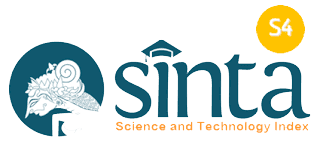The Effect of Discipline and Work Environment on Employee Performance in Ciputat Sector Police
(1) Universitas Pamulang
(*) Corresponding Author
DOI: https://doi.org/10.26858/pdr.v3i2.13258
Abstract
Human Resources (HR) is very important to be able to carry out the role of tasks, operationalize the available technology and provide innovative and creative thinking. The purpose of this study was to determine how the Effect of Discipline and Work Environment on Employee Performance in Ciputat Sector Police, where the independent variables studied were Discipline (X1) and Work Environment (X2), while the dependent variable was Employee Performance (Y). This method uses a quantitative approach, with the nature of descriptive associative research. The statistical tool used in the form of multiple linear regression, and carried out through the SPSS program 20 populations taken were Ciputat Sector Police officers as many as 108 people and the sample technique used was using the Slovin formula so that the number of respondents sampled was 52 people. In testing the hypothesis the author uses the t test for partial hypotheses and the f test for simultaneous hypotheses. Based on partial hypothesis testing using the f test and t test where the test results show that the fcount is 201.736> and f table is 3.190 which means the independent variable (X) has an influence on employee performance while the results of the t test results in disciplinary variables produce t arithmetic 4,613> and t table 2,009 which means tcount> ttable and work environment variables produce t arithmetic of 6.353> and t table of 2.009 which means tcount> with a contribution value of 89.2% which means that the contribution of the Disciplinary variable ( X1) and Work Environment (X2) affect the variable Y (Employee Performance) that is equal to 89.2% while the remaining 10.8% variable Y (Employee Performance) is influenced by other factors not examined by the author.
Keywords
Full Text:
PDFReferences
Agiskawati, A., Jamaluddin, J., Nasrullah, M., & Salam, R. (2018). Efektivitas Pemanfaatan Komputer pada Kantor Pengadilan Tata Usaha Negara Makassar. Jurnal Office, 4(1), 13–18.
Dessler, G. (2015). Manajemen Sumber Daya Manusia. In Jakarta: Salemba Empat.
Dika Arizona, H. R. dan N. H. (2013). Analisis Pengaruh Gaya Kepemimpinan, Motivasi Kerja dan Komitmen Organisasional terhadap Kinerja Pegawai (Studi pada Dinas Kelautan dan Perikanan Kabupaten Malang). Api Student Journal.
Ginanjar, A., Salam, R., & Hermanto, F. (2017). Penggunaan Facebook sebagai Media Pembelajaran IPS. JOINT INTERNATIONAL SEMINAR.
Hasibuan, M. S. P. (2011). Manajemen Sumber Daya Manusia. Edisi Revisi Jakarta: Bumi Aksara.
Mahardhika, T. S. (2017). Hubungan Antara Masa Kerja Dengan Stres Kerja Pada Tenaga Kerja Bagian Winding di PT Iskandar Indah Printing Textile Surakarta. Jurnal Keperawatan.
Marwansyah. (2010). Manajemen Sumber Daya Manusia. Alfabeta: Jakarta. https://doi.org/10.1017/CBO9781107415324.004
Musliha Fitri, A. (2013). Analisis Faktor-faktor yang Berhubungan dengan Kejadian Stres Kerja pada Karyawan Bank (Studi pada Karyawan Bank Bmt). Jurnal Kesehatan Masyarakat Universitas Diponegoro.
Noviansyah, Z. &. (1989). Pengaruh Stres Kerja Dan Motivasi Kerja Terhadap Kinerja Karyawan PT. Perkebunan Minanga Ogan Baturaja. Journal of Chemical Information and Modeling. https://doi.org/10.1017/CBO9781107415324.004
Octarina, A., & Arischa. (2013). Pengaruh Etos Kerja Dan Disiplin Kerja Terhadap Kinerja Pegawai Pada Dinas Kebudayaan Pariwisata Pemuda Dan Olahraga Kabupaten Sarolangun. Manajemen S-1. https://doi.org/10.1017/CBO9781107415324.004
Opka, D. (2008). Pemasaran Jasa. Akademik. https://doi.org/10.1177/0300985809357753
Peter, J. P., & Olson, J. C. (2014). Perilaku Konsumen dan Strategi Pemasaran. In salemba empat.
Rahadi, D. R. (2010). Manajemen Kinerja Sumber Daya Manusia. In Applied Physics A: Materials Science and Processing. https://doi.org/10.1007/s00339-002-1913-7
Ramadhani, S. D. (2016). Pengaruh Kepemimpinan Dan Motivasi Terhadap Kinerja Pegawai Di Balai Pengembangan Kegiatan Belajar (Bpkb) Daerah Istimewa Yogyakarta (Diy). In Jurnal Ilman.
Saggaf, M. S., Aras, M., Akib, H., Salam, R., Baharuddin, A., & Kasmita, M. (2018). The Quality Analysis of Academic Services Based on Importance Performance Analysis (IPA).
Saggaf, S., Salam, R., Kahar, F., & Akib, H. (2014). Pelayanan Fungsi Administrasi Perkantoran Modern. Jurnal Ad’ministrare, 1(1), 20–27.
Sari, R., Muis, M., & Hamid, N. (2012). Pengaruh Kepemimpinan, Motivasi, Dan Stres Kerja Terhadap Kinerja Karyawan Pada Bank Syariah Mandiri Kantor Cabang Makassar. Jurnal Analisis.
Sedarmayanti. (2017). Manajemen Sumber Daya Manusia. In Manajemen Sumber Daya Manusia.
Siagian, S. P. (2015). Manajemen Sumber Daya Manusia. In Jakarta : Bumi Aksara.
Sunarsi, D. (2018). Seminar Perencanaan Sumber Daya Manusia. ISBN - 978.602.70082.1.7.
Sutisna. (2003). Perilaku Konsumen: Teori dan penerapannya dalam Pemasaran. Ghalia Indonesia, Jakarta. https://doi.org/10.1007/BF01013984
Swastha, Basu, I. (2014). Manajemen Pemasaran Modern. In Liberty, Yogyakarta. https://doi.org/10.1017/CBO9781107415324.004
Wartono, T. (2017). Pengaruh Stres Kerja Terhadap Kinerja Karyawan (Studi Pada Karyawan Majalah Mother and Baby). Jurnal Ilmiah Prodi Manajemen Universitas Pamulang.
Wirawan. (2015). Manajemen Sumber Daya Manusia Indonesia. In Depok.
Yuswani, W. (2016). Pengaruh Budaya Organisasi dan Stress Kerja dan Dampaknya Terhadap Kinerja Karyawan Pada PT. Kerinci Permata Motor Jambi. Jurnal Sainstech Politeknik Indonusa Surakarta.
Article Metrics
Abstract view : 267 times | PDF view : 78 timesRefbacks
- There are currently no refbacks.
Copyright (c) 2020 Rima Handayani


































